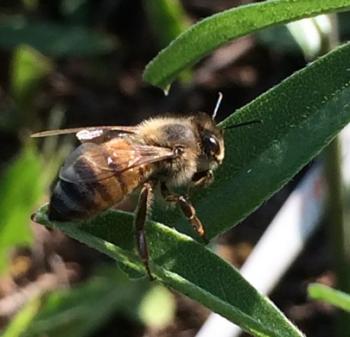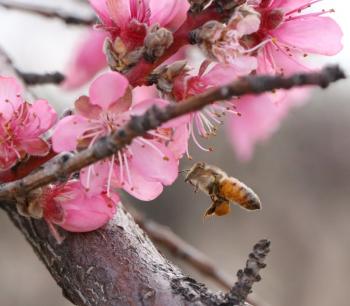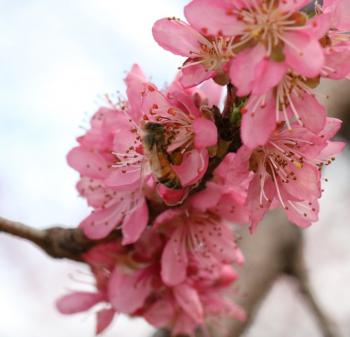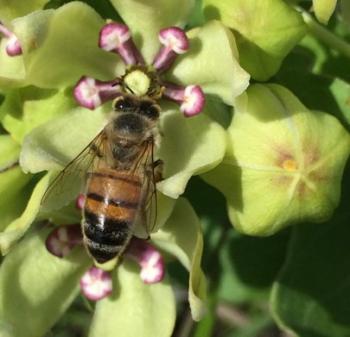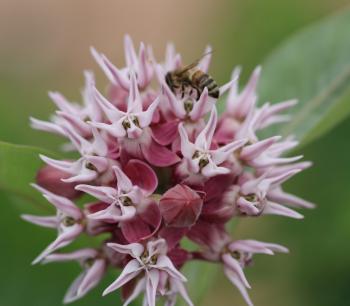Honey Bees in New Mexico
What Is A Honey Bee?
Honey bees are important insect pollinators for agricultural crops in New Mexico and across the U.S. Nationally, they contribute up to $20 billion 1 annually in pollination services to the agriculture industry. Their products (honey, pollen) are also a popular health foods and generate up to $320 million annually 2. Honey bees are considered an introduced species since they were first brought to the U.S. by beekeepers in the early 1600s. The majority of these managed pollinators live in a colony that is cared for by a beekeeper, who monitors their health and provides additional resources. There are some colonies that have escaped from apiaries and are now considered wild or unmanaged.
Honey Bees in New Mexico
In New Mexico, the annual number of honey bee colonies in ranges from between 3,100 to 6,000 colonies. This dramatic change is due to several factors such as, colony loss, creation of new colonies through splitting existing colonies, and hives being moving-in from other states (data originated from USDA NASS). Urban beekeeping is the most common beekeeping practice in New Mexico, with > 80 % apiaries located in urban areas: Albuquerque (> 100 apiaries), Farmington (5-10 apiaries), Santa Fe (5-10 apiaries), Las Cruces (5-10 apiaries), and Los Lunas and Belen area (5-10 apiaries), according to apiary registration locations through Beecheck (beecheck.org). Many other towns or natural areas have fewer apiaries registered (< 5 apiaries for each area). Because there is not a registration requirement in the state of New Mexico, many beekeepers do not register their hives or report honey yield, so the number of honey bee colonies, their distribution, and honey yield is not completely accurate for the state.
Honey Production and Pollination
Mesquite and alfalfa honey can be harvested in early summer in New Mexico and purchased from local beekeepers and grocery stores. Pollen and nectar from many other desert plants, such as tamarisk (or saltcedar), desert willow, cacti, and Russian Sage, can be collected honey bees for a mix honey when nectar from one plant source is not enough for a honey yield. Large acres of cotton, onion, and cover crops (such as clover, buckwheat) can also be used as a resource. Honey bees are commonly used for alfalfa and melon pollination in New Mexico: however, many other common crops in New Mexico benefit from honey bee pollination such as apple, pear, peach, plum, and onion.
Challenges of Beekeeping and Protecting Other Pollinators
Several major factors contribute to the high colony mortality rate 3 that is prevalent in New Mexico. Honey bees are threatened by loss of resources (habitat, food), increased pest and disease pressure, pesticide exposure, and a combination of these things working together to decrease honey bee health and vitality. Other pollinators are also challenged by many of the same stressors that honey bees face. Specifically, Varroa mite (pest and vector of virus disease) in bee hive is the leading factor for the high honey bee colony mortality, and integrated pest management is recommended for an effective approach for Varroa control resulting in reduced usage of pesticides in hives and healthier honey bees. The following suggestions can be used to benefit both honey bees and wild pollinators:
- Adding pollinator habitat to enhance landscapes will mitigate the stress from habitat loss and fragmentation in the arid and semiarid climate found in New Mexico. Pollinator habitats can support many different kinds of wild pollinators and beneficial insects.
- When pesticide use is unavoidable, select narrow spectrum, targeted pesticides to help reduce exposure to insect pollinators.
- Avoid spraying pesticides during the major blooming time of crops, landscape plants. If pesticide application is necessary during blooming periods, spray in the late afternoon when foraging activities are low.
Related Readings and Resources
References
- American Beekeeping Federation, 2020. Pollination Facts. Web. Accessed Nov. 8, 2020. Honey Bees Are Pollinators.
- National Agriculture Statistics Service. 2019. Statistical Summary: Honey Bees. Web. Accessed March 39, 2021. Statistical Summary: Honey Bees (PDF).
- Bee Informed Partnership.
